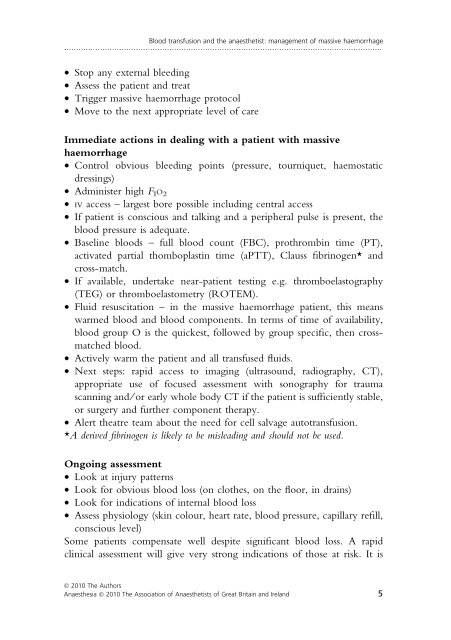Blood transfusion and the anaesthetist: management of ... - aagbi
Blood transfusion and the anaesthetist: management of ... - aagbi
Blood transfusion and the anaesthetist: management of ... - aagbi
You also want an ePaper? Increase the reach of your titles
YUMPU automatically turns print PDFs into web optimized ePapers that Google loves.
<strong>Blood</strong> <strong>transfusion</strong> <strong>and</strong> <strong>the</strong> anaes<strong>the</strong>tist: <strong>management</strong> <strong>of</strong> massive haemorrhage<br />
.....................................................................................................................................<br />
• Stop any external bleeding<br />
• Assess <strong>the</strong> patient <strong>and</strong> treat<br />
• Trigger massive haemorrhage protocol<br />
• Move to <strong>the</strong> next appropriate level <strong>of</strong> care<br />
Immediate actions in dealing with a patient with massive<br />
haemorrhage<br />
• Control obvious bleeding points (pressure, tourniquet, haemostatic<br />
dressings)<br />
• Administer high F IO 2<br />
• IV access – largest bore possible including central access<br />
• If patient is conscious <strong>and</strong> talking <strong>and</strong> a peripheral pulse is present, <strong>the</strong><br />
blood pressure is adequate.<br />
• Baseline bloods – full blood count (FBC), prothrombin time (PT),<br />
activated partial thomboplastin time (aPTT), Clauss fibrinogen* <strong>and</strong><br />
cross-match.<br />
• If available, undertake near-patient testing e.g. thromboelastography<br />
(TEG) or thromboelastometry (ROTEM).<br />
• Fluid resuscitation – in <strong>the</strong> massive haemorrhage patient, this means<br />
warmed blood <strong>and</strong> blood components. In terms <strong>of</strong> time <strong>of</strong> availability,<br />
blood group O is <strong>the</strong> quickest, followed by group specific, <strong>the</strong>n crossmatched<br />
blood.<br />
• Actively warm <strong>the</strong> patient <strong>and</strong> all transfused fluids.<br />
• Next steps: rapid access to imaging (ultrasound, radiography, CT),<br />
appropriate use <strong>of</strong> focused assessment with sonography for trauma<br />
scanning <strong>and</strong> ⁄ or early whole body CT if <strong>the</strong> patient is sufficiently stable,<br />
or surgery <strong>and</strong> fur<strong>the</strong>r component <strong>the</strong>rapy.<br />
• Alert <strong>the</strong>atre team about <strong>the</strong> need for cell salvage auto<strong>transfusion</strong>.<br />
*A derived fibrinogen is likely to be misleading <strong>and</strong> should not be used.<br />
Ongoing assessment<br />
• Look at injury patterns<br />
• Look for obvious blood loss (on clo<strong>the</strong>s, on <strong>the</strong> floor, in drains)<br />
• Look for indications <strong>of</strong> internal blood loss<br />
• Assess physiology (skin colour, heart rate, blood pressure, capillary refill,<br />
conscious level)<br />
Some patients compensate well despite significant blood loss. A rapid<br />
clinical assessment will give very strong indications <strong>of</strong> those at risk. It is<br />
Ó 2010 The Authors<br />
Anaes<strong>the</strong>sia Ó 2010 The Association <strong>of</strong> Anaes<strong>the</strong>tists <strong>of</strong> Great Britain <strong>and</strong> Irel<strong>and</strong> 5

















